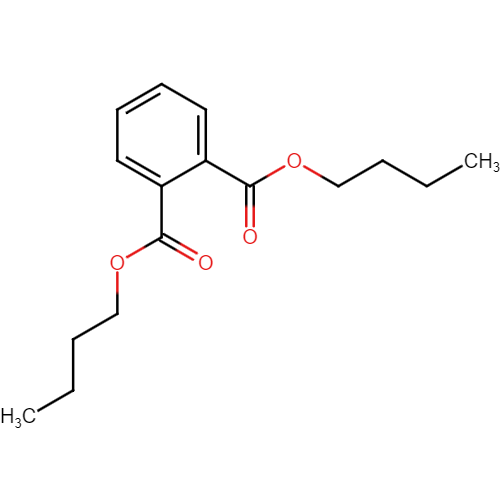Dibutyl Phthalate
| Compound Structure: |

|
||||||||||||||||||||||||||||||||||||||||||||||||||
|---|---|---|---|---|---|---|---|---|---|---|---|---|---|---|---|---|---|---|---|---|---|---|---|---|---|---|---|---|---|---|---|---|---|---|---|---|---|---|---|---|---|---|---|---|---|---|---|---|---|---|---|
| Synonyms: | dibutyl phthalate;84-74-2;Di-n-butyl phthalate;n-Butyl phthalate;Butyl phthalate;Genoplast B;Palatinol C;Celluflex ; Dibutyl 1,2-benzenedicarboxylate;Phthalic acid dibutyl ester;dibutyl benzene-1,2-dicarboxylate;1,2-Benzenedicarboxylic acid, dibutyl ester | ||||||||||||||||||||||||||||||||||||||||||||||||||
| Compound ID: | NMPC-018 | ||||||||||||||||||||||||||||||||||||||||||||||||||
| PubChem ID: | |||||||||||||||||||||||||||||||||||||||||||||||||||
| Molecular Formula: | C16H22O4 | ||||||||||||||||||||||||||||||||||||||||||||||||||
| Canonical SMILES: | CCCCOC(=O)C1=CC=CC=C1C(=O)OCCCC | ||||||||||||||||||||||||||||||||||||||||||||||||||
| InChIKey: | DOIRQSBPFJWKBE-UHFFFAOYSA-N | ||||||||||||||||||||||||||||||||||||||||||||||||||
| About the compound: | Dibutyl
phthalate (DBP) is an organic compound extensively utilized as a plasticizer
due to its minimal toxicity and broad liquid range. Its chemical structure is
denoted by the formula C6H4(CO2C4H9)2, and in its pure form, it appears as a
colorless oil. However, commercial samples of DBP often exhibit a yellowish hue
due to the presence of impurities. DBP is synthesized through a chemical
reaction involving n-butanol and phthalic anhydride. It plays a critical role
as a plasticizer, particularly in enhancing the properties of key engineering
plastics like PVC (polyvinyl chloride). PVC that has been modified with DBP
finds extensive use in plumbing systems, especially for transporting sewage and
other corrosive materials, due to its improved utility. When DBP undergoes
hydrolysis, it breaks down into phthalic acid and 1-butanol. A significant
metabolite of DBP is monobutyl phthalate (MBP). The biodegradation of DBP,
particularly through microbial action, is a vital process for its environmental
remediation. Certain microorganisms, such as species of Enterobacter, are
capable of biodegrading DBP in municipal solid waste, where its concentration might
reach as high as 1500 ppm. In these conditions, DBP has a half-life of about
2-3 hours. Interestingly, these microorganisms can completely degrade dimethyl
phthalate over a period of six days. Additionally, the white rot fungus
Polyporus brumalis is known for its ability to degrade DBP. Another
environmental concern is the leaching of DBP from landfills, highlighting the
importance of understanding and managing its lifecycle in various ecosystems. Safety and Hazard GHS Hazard Statements H360Df: May damage the unborn child;
Suspected of damaging fertility [Danger Reproductive toxicity]
H400: Very toxic to aquatic life [Warning
Hazardous to the aquatic environment, acute hazard] |
||||||||||||||||||||||||||||||||||||||||||||||||||
| Properties: |
Chemical
and Physical Properties
Source: PubChem |
||||||||||||||||||||||||||||||||||||||||||||||||||
| Source Species: |
Anacardium occidentale Annona senegalensis Crateva adansonii Musa sapientum Nymphaea lotus Spondias mombin Terminalia superba Musa acuminata Grewia mollis Parkia biglobosa |